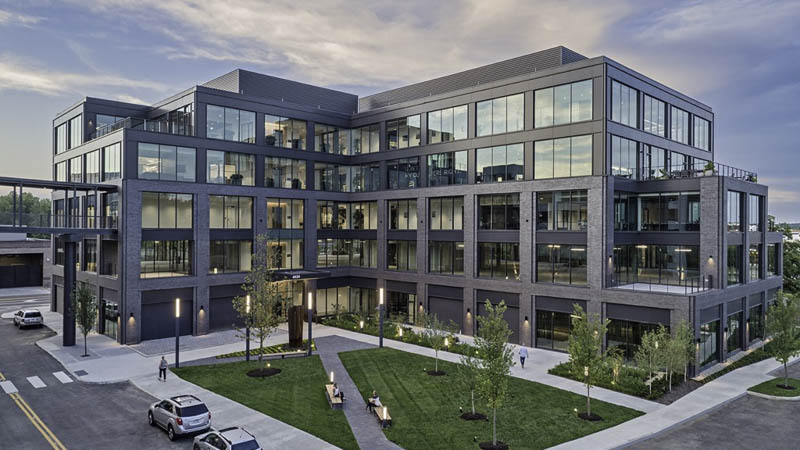Discover the Ingenious Services Used by Commercial Architects for Your Following Project
Commercial architects play an essential role fit the built environment. They blend functionality with aesthetic allure, producing spaces that resonate with brand identification. These professionals utilize innovative design remedies, lasting methods, and progressed innovations to enhance user experiences. Their collective approach guarantees alignment with customer visions and operational requirements. Nevertheless, the degree of their solutions frequently extends past layout. The following action in recognizing how these architects browse complicated job needs might amaze you.
Recognizing the Function of Commercial Architects
The function of commercial architects may vary depending on the particular project, their primary function rotates around developing practical and aesthetically attractive rooms for businesses. These professionals are charged with recognizing the unique needs of each customer, whether it be a retail store, office structure, or industrial center. They perform extensive website analyses and team up with stakeholders to assure that the design lines up with business goals and brand identity.Commercial architects additionally navigate various regulatory requirements, securing compliance with zoning regulations and building codes. Their competence reaches producing sustainable styles that advertise power effectiveness and ecological obligation. In addition, they handle the project's timeline and budget, collaborating with contractors and engineers throughout the building procedure. By mixing creative thinking with technological expertise, industrial architects play an essential duty in transforming theoretical ideas into concrete truths, inevitably boosting the capability and charm of commercial rooms.
Innovative Design Solutions for One-of-a-kind Spaces
As industrial spaces increasingly require distinctiveness to stick out in competitive markets, innovative layout remedies have become necessary for architects. These professionals take advantage of their creative thinking and technical know-how to craft unique settings that mirror brand identity and boost customer experience. By integrating advanced modern technology and materials, business architects can transform average areas into captivating places that engage consumers and inspire employees.Architects utilize various methods, such as flexible reuse, which renews existing frameworks while maintaining their historic importance. They likewise check out unique formats and multifunctional rooms that deal with diverse needs, making certain adaptability for future growth.Furthermore, the consolidation of biophilic design-- bringing nature indoors-- develops inviting environments that promote well-being - commercial architects. This attention to detail in ingenious layout not just addresses aesthetic worries but likewise cultivates neighborhood and cooperation. Inevitably, these tailored remedies permit services to flourish in an ever-evolving landscape, establishing them besides competitors
Lasting Design Practices
Lasting design methods have actually become a critical emphasis for industrial architects looking for to produce impactful styles that reverberate with ecological stewardship. These methods prioritize using renewable resources, energy performance, and marginal waste, showing a commitment to decreasing the ecological footprint of structures. Architects include materials that are sustainably sourced or recycled, making sure that construction methods straighten with environmental principles.Furthermore, the combination of eco-friendly roofing systems and walls enhances biodiversity while enhancing energy performance. Efficient water monitoring systems, such as rain harvesting, add to sustainability by conserving water sources. Natural air flow and daylighting strategies are also utilized to maximize interior environments, lowering reliance on man-made heating and lights.
Integrating Modern Technology in Architectural Styles
An enhancing number of business architects are accepting modern technology as a transformative component in building style. By leveraging sophisticated software tools such as Structure Details Modeling (BIM), architects can develop comprehensive 3D depictions of tasks, enabling enhanced visualization and cooperation among stakeholders. This modern technology promotes real-time modifications, reducing errors and improving the layout process.Additionally, architects are integrating clever building technologies right into their designs, which enhance power efficiency and occupant comfort. Functions such as automated illumination, environment control, and safety systems can be seamlessly integrated, advertising lasting methods and lowering operational costs.The use of digital and increased truth additionally permits clients to experience layouts prior to construction begins, offering invaluable insights into spatial connections and visual options. Inevitably, the assimilation of modern technology in building layouts not just cultivates development however also guarantees that projects are performed with precision and aligned with contemporary demands.

Job Management and Coordination Solutions
Effective job monitoring and sychronisation solutions are important for the effective execution of industrial building jobs. These solutions ensure that all facets of a job, from first design to last construction, are effortlessly incorporated. Commercial architects play a considerable duty in coordinating between numerous stakeholders, including clients, service providers, and vendors, to preserve clear interaction and placement on project goals.By carrying out organized methodologies, architects can handle timelines, budget plans, and sources properly, reducing delays and expense overruns. They use task monitoring software program and tools to track development, take care of documentation, and assist in collaboration among team members.Additionally, these solutions next page consist of risk evaluation and reduction techniques, validating potential obstacles are recognized and addressed proactively. The result is a structured procedure that boosts total task performance and top quality, inevitably bring about an effective end result that fulfills the customer's vision and assumptions.
Governing Compliance and Zoning Support
Efficient governing conformity and zoning assistance are necessary for the success of any kind of business task. Architects must have a deep understanding of neighborhood guidelines and zoning laws to lead customers through the intricacies of the approval procedure. This expertise not just guarantees adherence to legal requirements but also aids maximize job design and functionality.
Browsing Local Rules
Exactly how can commercial architects assure their styles line up with local guidelines? By staying educated regarding the ever-evolving landscape of building regulations and regional statutes, architects play a necessary role in ensuring compliance. They perform extensive study to understand the details laws governing products, safety and security requirements, and building and construction methods applicable to every project. Working together carefully with local authorities, business architects can navigate through the intricacies of regulatory structures successfully. They also assist in required authorizations and evaluations, simplifying the approval procedure. This positive technique not only alleviates potential legal complications however also improves task efficiency. Eventually, their know-how in maneuvering neighborhood laws equips clients to understand their vision while sticking to all required standards and guidelines.
Zoning Law Experience
Zoning regulation expertise is vital for industrial architects steering through the intricacies of land use policies. These architects possess extensive knowledge of local zoning codes, which govern residential property advancement, land usage, and building specs. By understanding these regulations, they assist customers browse the often elaborate approval processes required for building and construction tasks. Their proficiency assurances compliance with zoning laws, lessening the danger of project hold-ups or lawful complications.Additionally, commercial architects provide beneficial help in acquiring required permits and differences, assisting in smoother communications with regional authorities. They also supply calculated suggestions to maximize website layout and make the most of the possibility of a property while sticking to zoning restrictions. Inevitably, their zoning law efficiency plays a pivotal function in the effective awareness of business jobs.
Joint Techniques With Clients and Stakeholders
Effective commercial architecture rests on the capacity to promote solid collaboration with clients and stakeholders throughout the layout process - commercial architects. Architects involve in open discussions, ensuring that all celebrations' visions and needs are integrated right into the project. This joint method begins in the first phases, where architects carry out workshops and brainstorming sessions, enabling clients to verbalize their objectives and concerns.Stakeholder input is similarly crucial; architects commonly arrange meetings with neighborhood participants, neighborhood governments, and other appropriate entities to collect diverse point best site of views. By utilizing visualization devices, such as 3D modeling, architects facilitate better understanding and communication.This repetitive comments process not only improves design high quality yet additionally builds trust, causing even more effective end results. Inevitably, the joint ideology of commercial architects changes concepts right into practical areas that reflect the desires of clients and the wider area, making sure an unified relationship throughout the job lifecycle

Frequently Asked Questions
What Is the Regular Timeline for a Commercial Style Task?
The regular timeline for a business style task differs, normally covering 6 to 18 months. Factors affecting this duration consist of project intricacy, governing authorizations, and customer responsiveness, affecting each phase from layout to building conclusion.
How Do Commercial Architects Cost for Their Services?
Commercial architects normally charge based on project extent, intricacy, and size. Typical charge structures consist of hourly rates, dealt with charges, or percentage-based costs computed from the total building and construction expense, making certain transparency and positioning with client expectations.
Can Commercial Architects Aid With Interior Decoration?
Commercial architects can without a doubt assist with interior decoration, integrating performance and appearances. Their competence assurances cohesive areas that straighten with architectural vision, improving customer experience while meeting regulative needs and customer objectives through ingenious design services.
What Kinds of Customers Do Commercial Architects Usually Function With?
Commercial architects generally work together with varied customers, consisting of businesses, government entities, academic institutions, and non-profit organizations (commercial architects). Each customer looks for my review here customized building solutions to satisfy specific functional and visual requirements for their jobs and settings
How Do Commercial Architects Remain Upgraded With Design Patterns?
Commercial architects remain updated with layout fads via continual education and learning, going to market seminars, taking part in professional networks, and researching arising modern technologies. They additionally work together with other professionals to gain understandings right into innovative materials and style techniques.